- 1. How Long is the Swim in a Triathlon?
- 2. What’s a Good Swim Time for a Beginner in a Triathlon?
- 3. 5 Tips for Beginning Triathletes
- 4. Must-Know Swim Stroke: Front Crawl (or Freestyle)
- 5. How to Stop your Legs from Sinking in the Swim
- 6. How Do I Engage my Core?
- 7. Should I Breathe on Both Sides?
- 8. 5 Tips for Swimming in Open Water
- 9. Preparing for Your First Race
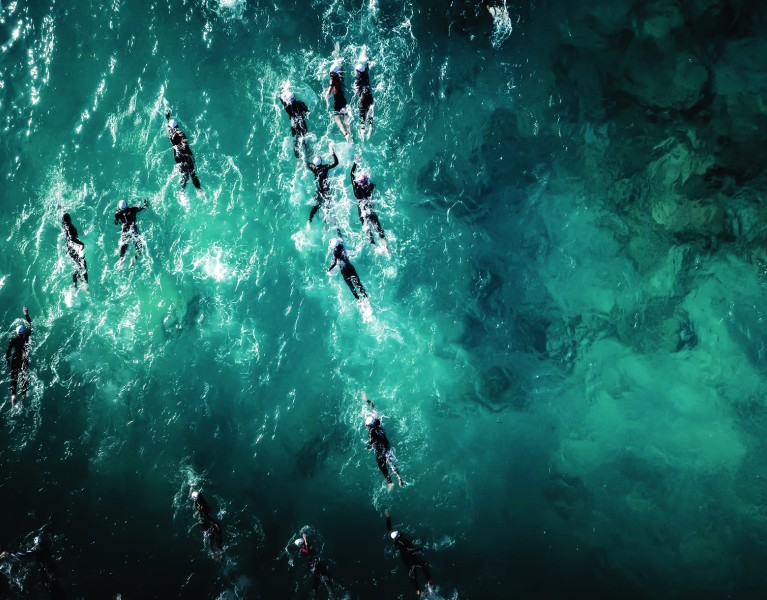
How to Train for Triathlon Swim
Table of Contents [Show]
For many, competing in a triathlon is a lifelong goal. Motivation often comes from a desire to live a healthier lifestyle, push yourself beyond your limits, or simply prove that you are up to an intense, physical challenge.
Triathlon can be an opportunity to kick your health into high gear, so you can ensure a fitter, more active future ahead. In addition to self-motivation, participating in a triathlon can also inspire your loved ones to take control of their own health habits.
We know the why, but what about the how when training for a triathlon? When it comes to swimming, even seasoned athletes can feel a little “wet behind the ears!” For many, the swimming portion may be the most intimidating as people generally tend to have less long-distance swimming experience. This guide will answer your questions and break down the steps to help you tackle the daunting first leg of triathlon.
How Long is the Swim in a Triathlon?
The two most common types of triathlons are sprint and standard/Olympic distance triathlons. Here is a breakdown of the distance for each type:
- Sprint Triathlon—750-meter (0.465 mile) swim / 20-kilometer (12.5 mi) bike / 5 km (3.1 mi) run
- Standard or Olympic Triathlon—1.5-kilometer (0.93 mile) swim / 40km (25 mi) bike / 10 km (6.2 mi) run
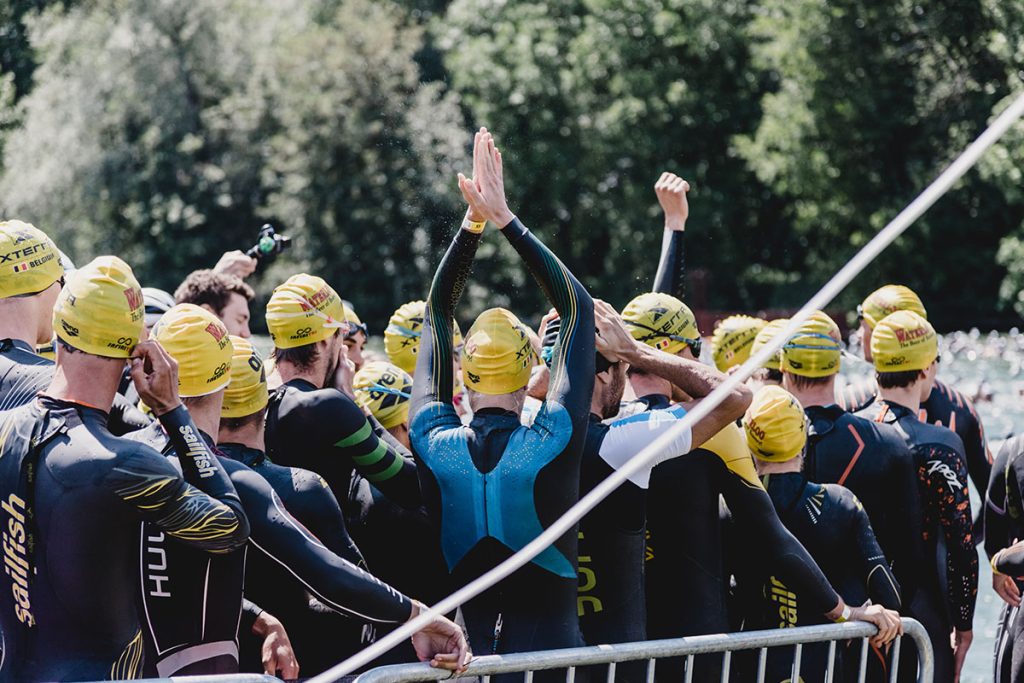
What’s a Good Swim Time for a Beginner in a Triathlon?
An achievable goal for most beginner triathletes is to swim 100 yards in two minutes. For the sprint triathlon, this would equal about 13-14 minutes. If you’re competing in an Olympic, this would mean a goal of around 27-30 minutes.
5 Tips for Beginning Triathletes
1. Warm-up before the race
Make sure to properly stretch before your race. Enter the water for 10-15 minutes before the race, and start moving your body to get your blood flowing and to get in your competition mindset.
2. Grab all the proper gear
Make sure to invest in a comfortable, high-quality race kit (this is the outfit you’ll wear for the entire race.) These are designed to dry quickly after your swim and should fit snug. For colder water temperatures, you need a triathlon-specific wet suit. Make sure to test your goggles before your race to ensure they seal to your face correctly.
3. Don’t “Overkick”
Because the rest of the triathlon will require more leg power, don’t overtire your legs during the swim. Instead, your arms should be doing most of the work. Aim for an 80:20 ratio in terms of effort of arms to legs with about three kicks per pull. To make the most of your effort, the flutter kick should be generated from the thigh and glute, not the knee.
4. Be Aware of Sighting
Don’t forget to pay attention to where you are. Try to focus on something easy to see in the distance, and look for it every 5-6 strokes.
5. Be Positive!
It’s okay if you aren’t the strongest swimmer for your first race. Don’t let it stop you. Don’t focus on anybody passing you in the water, focus on what you can control, as well as what you can work on in the future. Have fun!
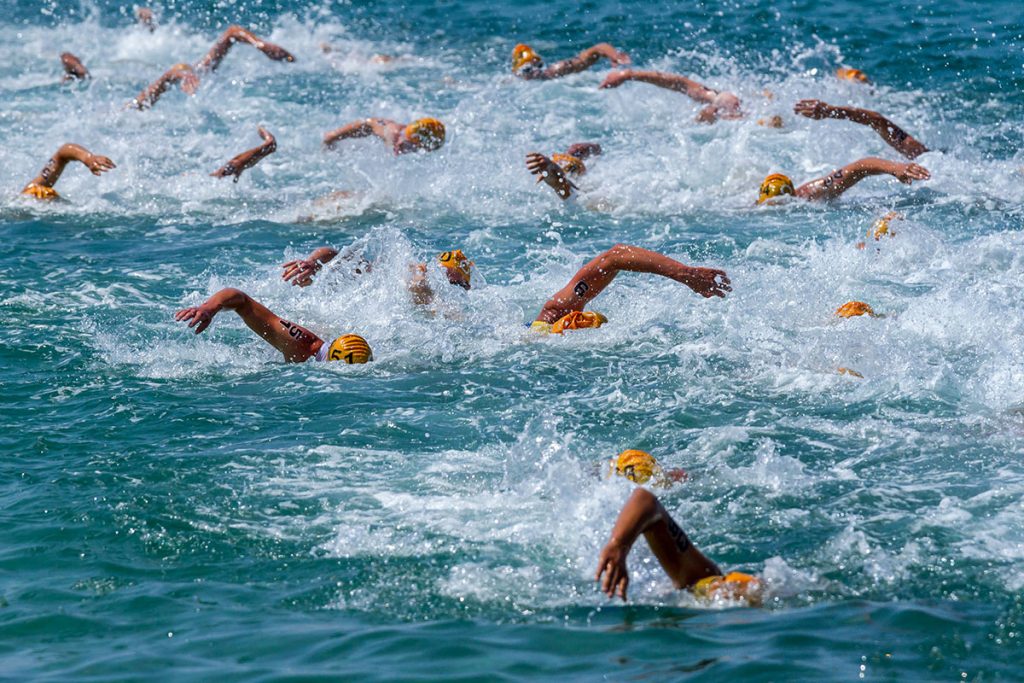
Must-Know Swim Stroke: Front Crawl (or Freestyle)
The front crawl is the most common stroke in freestyle races because it is the fastest. In this stroke, your body faces downward into the water. Your legs flutter kick, and your arms alternate reaching in front of you and pulling back underwater. Do your best to perfect this stroke, as good technique will allow you to vastly improve your swim time. Here are four aspects to focus on when practicing the front crawl:
The Catch — The catch is where your lead hand first touches the water. Make sure your arm is fully extended and that it meets the surface with a downward, slightly outward sweep.
Your fingers should stay relaxed but together. When you touch the water, change your hand position from horizontal to downward. Avoid the natural temptation to “glide” with your leading hand for too long. Your hand should enter the water smoothly, then angle toward the bottom after it's beneath the surface.
Keep your arm in line with your shoulder. If your arm is crossing in front of your body or too far outside, you will counteract your momentum.
The Pull — The pull is the part of the stroke where your arm moves through the water and flows back toward your feet.
The pull happens with your palm and your forearm. Make sure to flex slightly at the elbow, and keep it high to maximize your pull.
Make sure to get the timing right. One hand is at the end of the pull phase, while the other hand is extending forward to begin the pull phase. Keep in mind the natural balance of this alternating position.
The Exit — The push is when your arm exits the water. You’ll want to sweep back and slightly out, bringing your arm beyond the hip.
Your spine will naturally turn as you perform the arm exit. This allows you to take a breath without the need to lift your head out of the water.
Exhale underwater as your backhand is nearing the end of the push. Then, rotate to inhale as your hand begins its recovery towards the front to begin the next stroke.
The Kick — While your kicking technique is important, remember that most of your energy should come from your arms. Do not kick too hard. Your kick should be a whip-like motion that starts from your hip. Use your hips and the top of your thighs to start the kick, as your lower leg then whips down.
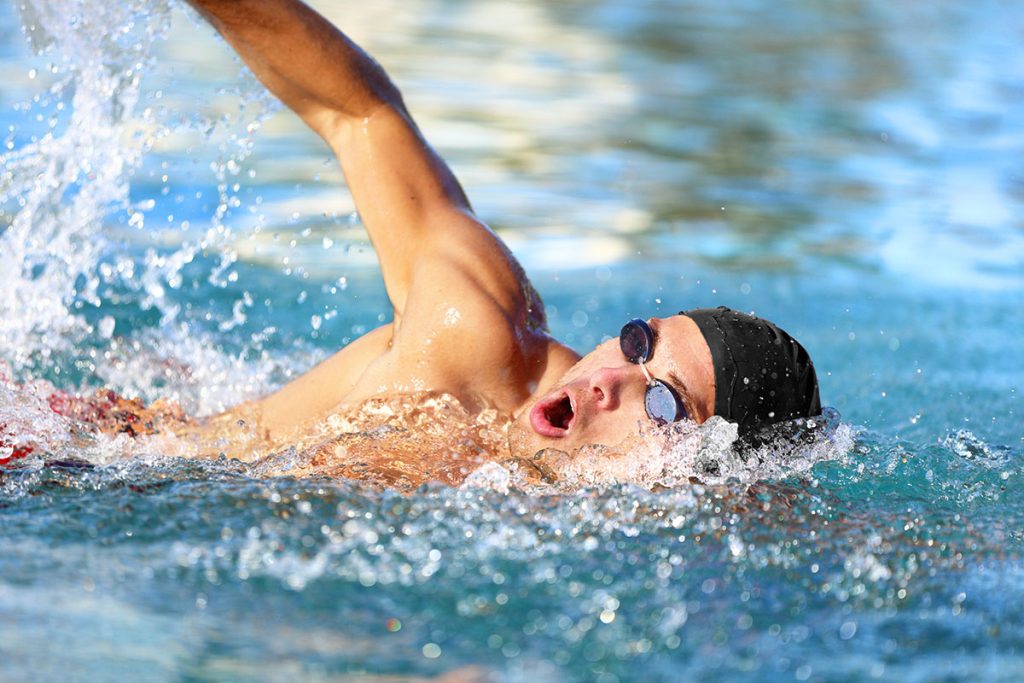
How to Stop your Legs from Sinking in the Swim
If your legs sink, they create drag and slow you down. Use your core strength to improve your body position. Kick conservatively: remember, you want to hit the ground running once you get out of the water.
There are two tricks to turn your legs into “flotation devices:”
- Exhale underwater to release positive buoyancy in your chest.
- Keep your head down to align your spine and raise your legs.
How Do I Engage my Core?
Engaging your core is a great way to improve your front crawl. Your core muscles - abs, glutes, and back - act as an anchor so your connected muscles can focus on generating power. An engaged core allows you to be more naturally buoyant, which helps with your body roll and takes the pressure off your shoulders.
Using your core prevents you from swaying from side to side. It also helps roll your hips and shoulders around this axis to give greater length and control to your stroke. Here’s a quick exercise you can use to practice engaging your core:
Dead man’s float — Hang limp and flat in the water; your legs may hang down to start. Take a deep breath, and lengthen your spine. Engaging your core muscles, lift your arms toward the surface, and look at the pool bottom. Point your toes, and you should start to feel an improvement.
Should I Breathe on Both Sides?
Yes. Alternating sides (or bilateral breathing) helps with symmetry and balance, and it improves your ability to sight. In open water, sighting is important to stay on course, avoid chop, and keep an eye on competitors. Try to breath every three to five strokes, switching sides each time.
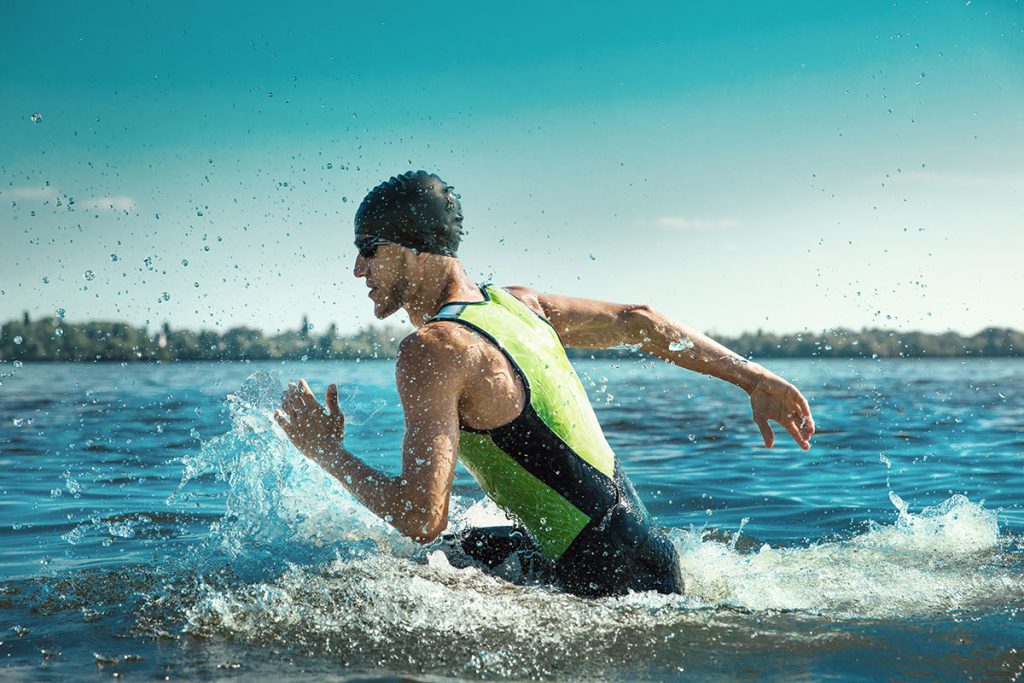
5 Tips for Swimming in Open Water
- Except when turning your head to breathe, keep your eyes toward the bottom. Looking forward and lifting your neck causes legs to sink.
- Remember to use a flat, wide hand entry with little or no glide/reach. Keep your hand relaxed and fingers slightly apart.
- A high elbow provides a strong anchor for the catch. Choppy conditions may mean you need to use a higher arm recovery. If your arm is too low, your hand may hit a wave and enter the water too early. Use arm recovery to wriggle fingers to relax arms and increase blood flow.
- Your backward pull should come straight to the side (rather than the “S” shape under the body). Maintain a hyperextended hand at the end of the stroke (as it is when you lift your body out of the pool) to maximize propulsion.
- Kick mainly from the hips, keep your ankles loose, and turn your feet slightly inwards. The downbeat of your kick should just break the surface of the water with your heels. Keep your legs high enough for good body position, and maintain a low effort, low drag kick to minimize the energy you expend.
Preparing for Your First Race
Training should begin anywhere between 2-4 months before your race, depending on your current fitness level. Many athletes find swimming to be the most challenging, as people tend to be less familiar with this portion. If you're new to swimming, consider joining a masters group or working with a coach.
For the swim portion, focus on strengthening your back, shoulders, and arms. Ideally, practice swimming at least once or twice a week, and take one to two rest days per week. Practice wearing a swim cap and the suit you plan to wear, especially if you aren’t used to wearing this type of equipment.
As you train, build up your endurance to so you're ready to complete the full distance on race day. As race day approaches, plan your food and equipment, and, get plenty of sleep. Whether it’s your first triathlon or your 10th, remember to congratulate yourself for your hard work.
Featured image by: Kirill_makarov.


